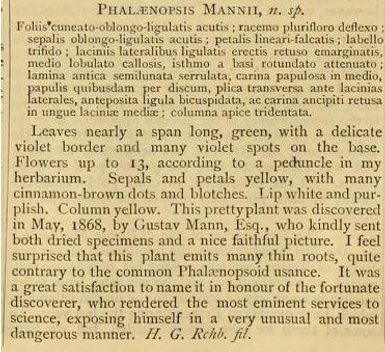
Foliis cuneato-oblongo-ligulatis acutis ; racemo plurifloro deflexo ; sepalis oblongo-ligulatis acutis : patalis linearis-falcatis ; labello trifido ; laciniis lateralibus ligulatis erectis retuso emarginatis, medio lobulato callosis, isthmo a basi rotundato attenuato ; lamina antica semilunata serrulata, carina papulosa in medio, papulis quibusdam per discum, plica transversa ante lacinias laterales, anteposita ligula bicuspidata, ac carina ancipiti retusa in ungue laciniae mediae ; columna apice tridentata.
Leaves nearly a span long, green, with a delicate violet border and many violet spot on the base. Flowers up to 13, according to a peduncle in my herbarium. Sepals and petals yellow, with many cinnamon-brown dots and blotches. Lip white and purplish. Column yellow. This pretty plant was discovered in May, 1868, by Gustav Mann, Esq., who kindly sent both dried specimens and a nice faithful picture. I feel surprised that this plant emits many thin roots, quite contrary to the common Phalaenopsoid usance. It was a great satisfaction to name it in honour of the fortunate discoverer, who rendered the most eminent services to science, exposing himself in a very unusual and most dangerous manner. H. G. Rchb. f.
Feuilles
d'une main de long, vertes avec une délicate bordure violette et de nombreux
points violets à la base. Fleurs, jusqu'à 13, selon un pédoncule dans
mon herbier. Sépales et pétales jaunes, avec de nombreux points
et tâches brun-canelle. Labelle blanc et pourpre. Colonne jaune. Cette
belle plante a été découverte en Mai 1868 par Gustave Mann qui m'en a
aimablement envoyé des specimens séchés et une belle et fidèle
représentation. Je suis surpris que cette plante émette de nombreuses
racines fines, tout à fait contraire aux habitudes des
Phalaenopsoids. Ce fut une grande satisfaction de le nommer en
l'honneur de l'heureux découvreur, qui a rendu les service les plus
éminents à la science, s'exposant de la plus inhabituelle et
dangereuse des manières. H.
G. Rchb. f.